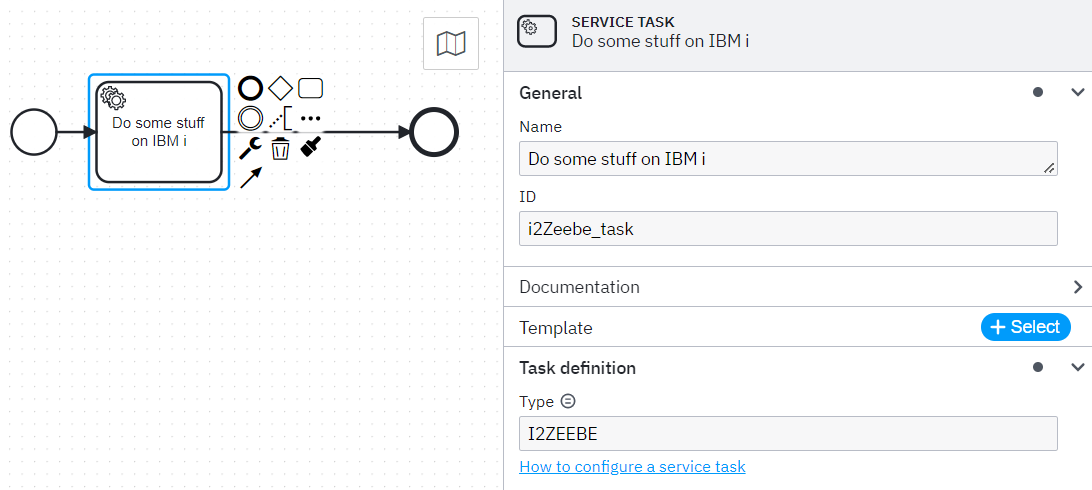Difference between revisions of "I2Zeebe"
| Line 243: | Line 243: | ||
<pre> | <pre> | ||
</pre> | </pre> | ||
| + | |||
| + | =Quickstart= | ||
| + | TODO | ||
| + | =i2Zeebe parameters= | ||
| + | TODO | ||
| + | ==Shell mode== | ||
| + | TODO | ||
| + | ==RPGLE mode== | ||
| + | TODO | ||
Revision as of 00:14, 30 August 2023
i2Zeebe works as a bridge between IBM i server and Zeebe process automation engine. You can use i2Zeebe as a native equivalent of zbctl utility or as Zeebe client library for use in your ILE RPG/C code. i2Zeebe represents IBM i program written on ILE C, which can be called from command line or any IBM i program. With i2Zeebe, you can interact with almost any Zeebe API (gRPC) directly from IBM i server.
Contents
What is Zeebe
According to the vendor, Zeebe is the workflow and decision engine that powers Camunda. Zeebe's cloud-native design provides the performance, resilience, and security enterprises need to future-proof their process orchestration efforts.
Quote:
With Zeebe you can:
- Define processes graphically in BPMN 2.0.
- Choose any gRPC-supported programming language to implement your workers.
- Build processes that react to events from Apache Kafka and other messaging platforms.
- Use as part of a software as a service (SaaS) offering with Camunda Platform 8 or deploy with Docker and Kubernetes (in the cloud or on-premises) with Camunda Platform 8 Self-Managed.
- Scale horizontally to handle very high throughput.
- Rely on fault tolerance and high availability for your processes.
- Export processes data for monitoring and analysis (currently only available through the Elasticsearch exporter added in Camunda Platform 8 Self-Managed).
- Engage with an active community.
For documentation on deploying Zeebe as part of Camunda Platform 8 Self-Managed, refer to the deployment guide.
What is i2Zeebe
i2Zeebe is native IBM i program which combines abilities of Zeebe CLI client and Zeebe client library for use on IBM i server platform. It uses parameters passed from command line or from calling program, to perform interaction to Zeebe process engine.
Examples of i2Zeebe usage
Command line interface
Topology request
call i2zeebe parm('Topology' '--gateway' 'http://gateway:26500' '--sync' '--print_response=joblog')
Depending on your Zeebe cluster configuration, this call will produce information in the job log like this (formatted here for clarity):
{
"http2_status": 200,
"http2_error": 0,
"grpc_status": 0,
"TopologyResponse": {
"brokers": [
{
"nodeId": 0,
"host": "node0",
"port": 26501,
"partitions": [
{
"partitionId": 1,
"role": "follower",
"health": "healthy"
},
{
"partitionId": 2,
"role": "follower",
"health": "healthy"
},
{
"partitionId": 3,
"role": "follower",
"health": "healthy"
}
],
"version": "8.2.7"
},
{
"nodeId": 1,
"host": "node1",
"port": 26501,
"partitions": [
{
"partitionId": 1,
"role": "follower",
"health": "healthy"
},
{
"partitionId": 2,
"role": "leader",
"health": "healthy"
},
{
"partitionId": 3,
"role": "follower",
"health": "healthy"
}
],
"version": "8.2.7"
},
{
"nodeId": 2,
"host": "node2",
"port": 26501,
"partitions": [
{
"partitionId": 1,
"role": "leader",
"health": "healthy"
},
{
"partitionId": 2,
"role": "follower",
"health": "healthy"
},
{
"partitionId": 3,
"role": "leader",
"health": "healthy"
}
],
"version": "8.2.7"
}
],
"clusterSize": 3,
"partitionsCount": 3,
"replicationFactor": 3,
"gatewayVersion": "8.2.7"
}
}
Activate jobs
Lets assume that we have published simple business process with service task that has type I2ZEEBE to our Zeebe cluster (http://gateway:26500):

Now we can start the process, for example from Camunda Modeller (press Start process button in the bottom of Modeller interface:

At this step, Zeebe process engine should wait for activation of I2ZEEBE task by some worker. Let's do it from IBMi command line interface:
call i2zeebe parm('ActivateJobs' '--sync' '--print_response' '--gateway' 'http://gateway:26500' '--jobType' 'I2ZEEBE' '--worker' 'I2ZEEBE')
Resulting job log:
{
"http2_status": 200,
"http2_error": 0,
"grpc_status": 0,
"ActivateJobsResponse": {
"jobs": [
{
"key": 6755399441390948,
"type": "I2ZEEBE",
"processInstanceKey": 6755399441390943,
"bpmnProcessId": "i2Zeebe_simple",
"processDefinitionVersion": 1,
"processDefinitionKey": 2251799814019882,
"elementId": "i2Zeebe_task",
"elementInstanceKey": 6755399441390947,
"customHeaders": "{}",
"worker": "I2ZEEBE",
"retries": 3,
"deadline": 1693331966076,
"variables": "{}"
}
]
}
}
Job has been activated for our job worker I2ZEEBE for 30 seconds (default value of --timeout).
CompleteJob
Now we will complete job activated on the previous step.
call i2zeebe parm('CompleteJob' '--gateway' 'http://gateway:26500' '--sync' '--print_response' 'joblog' '--jobKey' '6755399441390948')
Joblog shows the response:
{
"http2_status": 200,
"http2_error": 0,
"grpc_status": 0,
"CompleteJobResponse": {}
}
Call from ILE C program
i2Zeebe supports two modes of parameters - RPG mode and shell mode. We will demonstrate shell mode here:
#include <stdio.h>
#include "i2zeebe.h"
int main(int argc, char *argv[]) {
gateway_protocol_TopologyResponse TopologyResponse;
int grpc_status;
int nghttp2_error;
int http2_status;
char grpc_message[1000];
int grpc_message_len=1000;
I2ZEEBE("Topology",
"--sync",
"--gateway", "http://gateway:26500",
"--print_response", "stdout",
"--response", &TopologyResponse,
"--grpc_status", &grpc_status,
"--nghttp2_error", &nghttp2_error,
"--http2_status", &http2_status,
"--grpc_message", grpc_message,
"--grpc_message_len", grpc_message_len);
printf("Zeebe gateway version: %s\n", TopologyResponse.gatewayVersion);
return 0;
}
Call from ILE RPG program
To call i2Zeebe from RPGLE program, it is recommended to use pass parameters in RPG mode. In this mode, i2Zeege accepts fixed number of parameters - 5 for applying some action or 2 for releasing data allocated by previous call:
/Copy i2ZeebeCpy
/Free
// i2ZeebeCommon, i2TopologyResponse are defined in i2ZeebeCpy
i2ZeebeCommon.gateway = 'http://gateway:26500'+x'00';
i2ZeebeCommon.printResponse = 1;
i2ZeebeCommon.syncCall = 1;
// Call Topology request
I2ZEEBE('I2Z0100': // Request identifier. I2Z0100 = TopologyRequest
i2ZeebeCommon: // Common parameters for i2Zeebe calls
*NULL: // TopologyRequest parameters (none)
%Addr(i2ZTopologyResponse): // This structure will be filled with results
*NULL); // Exit program
//
// ... do some stuff with returned data
//
// Clean up returned data
I2ZEEBEX('I2Z0100':
%Addr(i2ZTopologyResponse));
Return;
/End-Free
Zeebe Worker mode
i2Zeebe supports synchronous and asynchronous communications with Zeebe gateway. It allows to build native IBMi Zeebe workers, as shown below (assuming happy path only):
Quickstart
TODO
i2Zeebe parameters
TODO
Shell mode
TODO
RPGLE mode
TODO